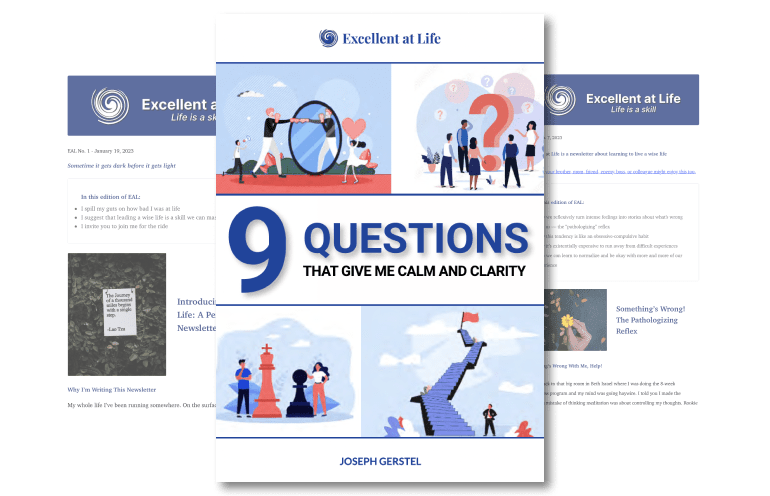Your Mind is A Wild Garden, You Can’t Control It
If you perchance remember where I left off in EAL #2 despite the pace of the matrix, I salute you. For the rest of us forgetful mortals, last we chatted I was in a dark tape closet doing mystical meditations and I really could have used someone whispering to me to ease up on the gas.
It took me a bit of time to realize I wasn’t in need of some transcendental high (though I love those!), but just of a way to calm a mind at war with itself, a way to tame the fires of self-loathing. It was a few years later when I finally worked my way around to doing an 8-week mindfulness course at Beth Israel Medical Center in Manhattan.
The room was a veritable palace compared to my tape closet, the lights were on, and the practice was much simpler: pay attention to your breathing. When your mind wanders, bring it back to the breath. When it wanders again, bring it back again. When it … what was I saying? Right. When it wanders again and again and again, bring it back again and again and again.
Ahhh… nirvana.
Or more like:
I’m sooo bored. Helllllppp! I can’t do this. Is this working? Why can’t I focus? Why can’t my mind just calm down? How is everyone else doing this? How did they get normal minds? My tush is hurting. Are we almost done? What?! It’s only five minutes in? There’s 2 hours left? This is such a waste of time, why pay attention to my breath anyway?
I was definitely making the mistake that meditators make when starting: I was trying to control my thoughts. Trying really, really hard actually and frankly not doing very well. I didn’t appreciate back then how this process needed patience or even what it really was. It takes wise and gentle effort to train your mind and turn it into a rose garden.
(Frankly, I’m skeptical that the breath or formal meditation in any form is even the right place to start for many people, especially if you’re an obsessive perfectionist or neurotic like me. There are critical attitudinal shifts that are needed and you need to have some sense of these first to be effective. If you sit down to meditate to suppress your thoughts or run away from difficult experience, you’re really just trying to fill a hole by digging at the bottom for more dirt.)
The Thought Screen — The World is Not Your Thoughts About It
Our minds are wild. They act of their own accord. And what they do is generate endless thoughts and feelings. These thoughts create a sort of fog screen between us and the world. They’re first-class storytellers, endlessly narrating on and on about how we messed up, how the person that cut us off is such a jerk (his poor wife!), and how only our computer crashes right before we saved all our work.
Your ability to live a good life depends on how well you learn to work with this thought screen.
Why? Because in our default mode we cannot distinguish between our thoughts about the world and the world itself. If we have the thought that someone is a jerk, they’re a jerk. Period. There’s no room for seeing that person’s good qualities or even just for the tiniest compassionate glimpse of why they’re behaving that way. All we see is their jerkness. And we can literally see them through that lens for a whole lifetime if we’re not careful.
I remember going to visit an elderly relative in her nineties some years back. She grew up in pre-war Poland, ran away to Russia to escape the Nazis, and then came over to America after the war. I can only imagine how traumatic that all was. Anyway, we were chit-chatting and she made some self-diminishing comment equating herself to dirt (or something horrible like that).
I was shocked. She had been through so much, lost much of her family, and rebuilt her own world as an immigrant from scratch, but had lived her entire life with a feeling of profound worthlessness.
And all this just because of a belief that she lacked the skill to recognize and work with. All it was, was a mental habit, a thought. A sticky one, to be sure, but still just a thought. But she thought it was reality, it was the world. So it was her world. For more than ninety years. Is that not a tragedy? This is serious stuff we’re talking about here!
To a greater or (hopefully) lesser degree, we are all plagued by thoughts like this. Our minds churn them out continuously. We incessantly doubt ourselves, judge ourselves, and accuse ourselves. We try to suppress them, control them, get rid of them, with little success.
So if we can’t control them, what then?
You Can’t Control Your Mind But You Can Work Skillfully With It
In the short run, there is little you can do to control your mind. But, 1) there is a lot that you can do to change how you relate to your experience now, and 2) there are many skillful ways to work with it that bear radical fruit over time.
Here is some of what you can do:
1. You can become more attentive to your thoughts and get to know them
This helps you begin to recognize particular thought patterns as distinct from the world. You begin to see the world more clearly. You see how your thoughts govern your behavior and create your reality. This can also fire up the motivation to learn to work with them — you’re gonna need that fire, it’s a long road baby!
2. You can create space between thought and action
Viktor Frankl famously put it this way: “Between stimulus and response there is a space. In that space is our power to choose our response. In our response lies our growth and our freedom.” This space can be expanded and there is an art to working with this space that is very learnable. The more you pay attention and get to know your mind, the more freedom to choose you create.
3. You can befriend your mind and preempt rumination
When we respond to troublesome thoughts with frustration or agitation, we fuel their energy and turn them into negative cascades or rumination rabbit holes. For example, suppose you got angry at a friend. You could let the anger dissipate (and make amends) or you could go on beating yourself up over how bad you are that you got angry.
Mindfulness texts liken this to someone who is it hit by an arrow and then stabs themselves with a second arrow (and often third or fourth arrows if you’re like me). The more we meet our experience with a friendly, kind, holding attitude, the more we can allow for thoughts and feelings to dissipate without carrying their energy forward.
4. You can come to understand the underlying feelings or desires driving them and work to resolve them
There is always unresolved emotion or sensation underneath sticky thought patterns. As we get to know our minds more, we learn to understand these feelings or desires and how to start letting them resolve wisely.
5. You can tune into your body and learn to calm your nervous system
The mind and body are deeply connected and by tuning in to your body gently, you can meet and calm the affective energies burning inside. Disturbing thoughts are a red herring, the smoke churned up by the body’s fire. Just like you don’t put out fire by spraying water on smoke, you don’t calm the mind by struggling with thoughts.
Cognitive therapy (often) makes the fundamental error of trying to work with thoughts directly, rather than working with the affect and somatic sensation generating them. It is the 1) aversion to the thought, and 2) the underlying feeling generating the thought, that we need to work with, not the thought itself.
By obsessing about changing the thought itself, we actually feed its energy. We give it significance and reinforce our avoidance of it. Instead, we can meet a thought with friendly presence (this stops it from cascading onwards) and then tune in gently to the feelings underneath it (this allows it to resolve over time).
6. You can learn to reduce their “epistemicity,” your felt sense of how true they are
Thoughts are “epistemic,” meaning they make a claim about the reality out there. If we feel socially awkward, they’re telling us people are judging us or no one likes us and it feels like this is actually true. Our natural reflex is to believe them and see the world through them, but they are a very bad shorthand for the real world.
As you attend to and become more familiar with your thoughts, you begin to see the thought screen for what it is: a virtual reality that obfuscates the real world. Even if you can’t pierce the screen initially, you at least start to know that you’re delusional. This is a huge step. Ultimately, we can learn to see through them and see the world more and more clearly.
7. You can cultivate wholesome states of mind and wise thoughts
Instead of leaving joy, kindness, calm, generosity, compassion, love, and connection, to happenstance, you can learn to nurture and encourage these states. The more you do so, the more they will visit you and the more deeply you will experience them.
——-
Your mind is like a garden planted by the unintentional wilds of the world. Left to its own, it grows the weeds of worry and anxiety, fear and anger, shame and sorrow, which we are inclined to naturally and which are encouraged by our unreflective social environment. If you want to beautify it, you have to cultivate it properly.
You cannot will it to be different. You can hack at the weeds above ground — fight your thoughts and feelings — they’ll just come right back. You need to do the work necessary to pacify them. That requires digging deep into the soil — tuning into your body and finding the affective source and allowing it to resolve.
You also need to cultivate beautiful things — to practice being kind, generous, joyous, forgiving, calm, loving, and compassionate. Over time the garden will tame and grow beautiful. But it takes time and patience for your wise efforts to bear fruit. Like drip irrigation, one little drip at at time.
Gardens need to be nurtured, not controlled.
Drip, drip, drip.
Joseph



